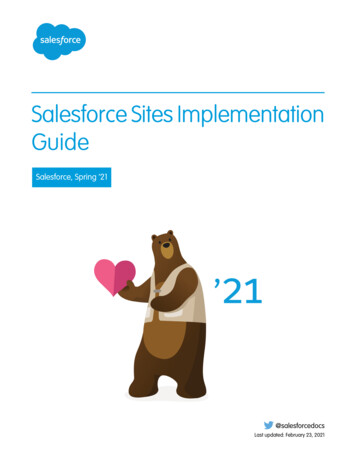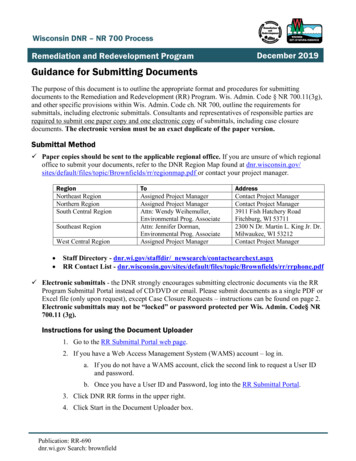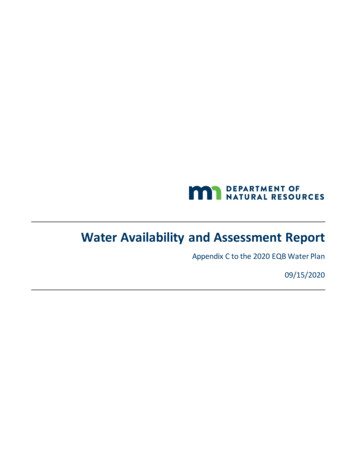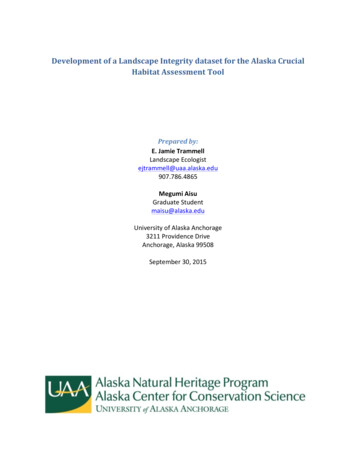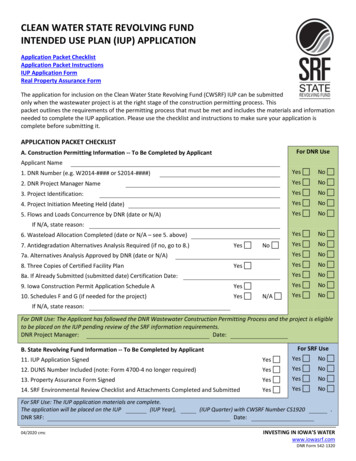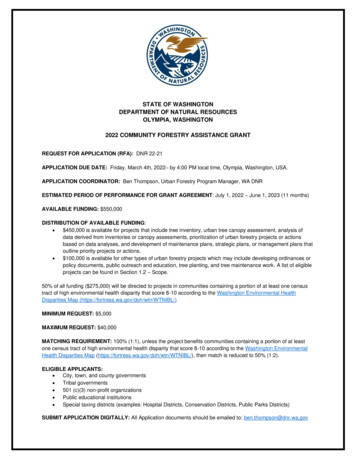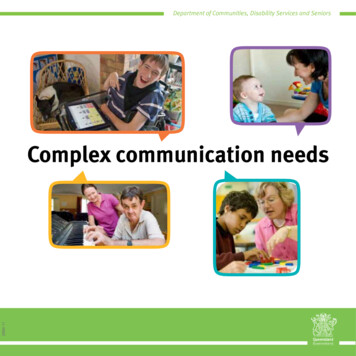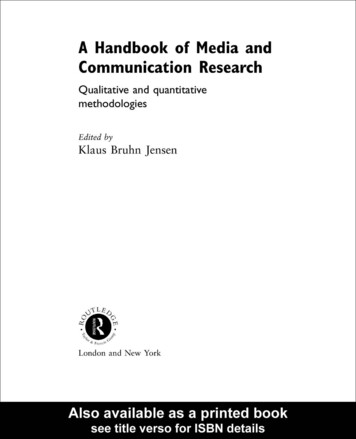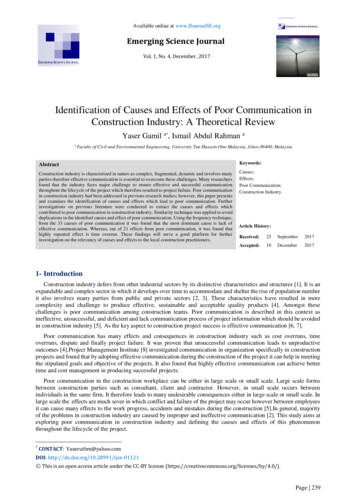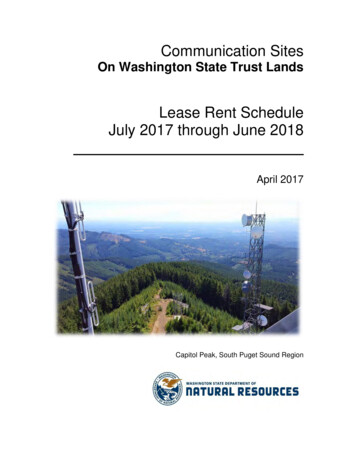
Transcription
Communication SitesOn Washington State Trust LandsLease Rent ScheduleJuly 2017 through June 2018April 2017Capitol Peak, South Puget Sound Region
Communication SitesOn Washington State Trust LandsLease Rent ScheduleJuly 2017 through June 2018April 2017Prepared by:Product Sales & LeasingCommunication Sites Leasing Program
Washington State Department of Natural ResourcesAdministrators for Communication SitesMap of DNR Regions and OfficesDNR RegionAdministrators PhoneMailing AddressTim Gallagher(509) 685-2708 Office225 South Silke RoadColville, WA 99114NorthwestJamie Hitt(360) 854-2837 OfficeOlympicLois Anderson(360) 819-3030 Cell(360) 902-1686 OfficePacific CascadeWalt PulliamLois Anderson(360) 902-1774 Office(360) 902-1686 OfficeWalt PulliamLois AndersonChad UnlandBecky Kennedy(360) 902-1774 Office(360) 902-1686 Office(509) 925-0935 Office(509) 925-0938 OfficeWalt PulliamLois Anderson(253) 736-3212 Cell(360) 819-3030 CellNortheastSouth Puget SoundSoutheastStatewide ProgramContacts, Olympia919 North Township StreetSedro Woolley, WA 982841111 Washington ST. SEPO Box 47061Olympia, WA 98504-70611111 Washington ST. SEPO Box 47061Olympia, WA 98504-7061950 Farman Ave. NEnumclaw, WA 98022713 Bowers Rd.Ellensburg, WA 989261111 Washington Street SEPO Box 47016Olympia, WA 98504-7016
Table of ContentsCOMMUNICATION SITES ON STATE TRUST LANDSINTRODUCTION1COMMUNICATION SITES PROGRAM1COMMUNICATION SITES RENT ADJUSTMENT METHODOLOGY2TERMINOLOGY3COMMUNICATIONS SITE CLASSES4LEASE RENTSNON-DNR FACILITY RENT5DNR FACILITY RENT6TOWER RENT FOR EQUIPMENT ON DNR TOWERS7FM AND TELEVISION BROADCASTER RENT8CELLULAR AND WIRELESS BROADBAND COMMUNICATION RENT9
Communication Sites onState Trust LandsIntroductionThe Communication Site Leasing Program is a part of the broader trust landsmanagement program. The Washington State Department of Natural Resources(DNR) manages 3 million acres of state trust lands to provide revenue and manybenefits for the public. Revenue helps fund construction of the state’s public schools,universities, other educational institutions, prisons, and buildings at the State Capitol;and helps fund services in many counties as well as contributing to the state generalfund, earmarked for education.Revenue-producing activities on state trust lands include harvest of timber and forestproducts, wind power, leasing of agricultural lands (orchards, vineyards, row crops, dryland crops, and grazing), mineral leases, and leasing of communication sites andcommercial properties.The Communication Site Leasing Program manages more than 100 sites acrossWashington, and distributes more than 3 million dollars in revenue annually that goesto the specific beneficiaries of the trusts.Communication Sites ProgramThe program originally began with the placement of surplus World War II radios, andearly commercial versions of these radios, in Washington State’s fire lookout towers.The Amplitude Modulation (AM) radios were the means of communication betweenhilltop lookout tower operators that supported the state’s fire suppression efforts. Afire lookout operator would relay a report of a fire to the Olympia dispatcher throughthe other lookout operators. This system was replaced in the 1960s with automatedradio repeaters operating on Frequency Modulation (FM). High elevation lookoutsites with panoramic views also were a natural fit for communication sites, soeventually, buildings were added by DNR, other state agencies and commercialbusinesses.Today DNR’s Communication Site Program is meeting the demand for ever-increasingcommunications infrastructure and technologies with the placement of buildings andtowers in many premium locations suitable for AM / FM and Broadcast Radio, 2-WayRadio, Television, Microwave Radio, Cellular and Wireless Broadband applications.The program leases state trust lands as sites for new communication facilities and forco-locating within DNR-managed facilities. The high elevation sites, especially thosethat overlook transportation routes and population areas, represent, in many cases,great opportunities for communication sites, especially microwave. Both the privateand public agency sectors recognize the value of the sites that have grownconsiderably over the years.Washington State Department of Natural Resources 2017-2018 Communication Sites Rent Schedule Page 1 of 9
Communication Site Rent Adjustment MethodologyDNR’s rent schedule for Communication Sites leases is published annually. Rentadjustment for the period from July 1, 2017 through June 30, 2018 represents an increaseof two percent (2%). The increase is based on communication site industry rent marketinformation. Annual rents typically increase by an average of three percent or the ratepublished by the Consumer Price Index, Urban Consumer, U.S. City Average, whicheveris higher. The following table lists recent rent increases.RENT ADJUSTMENT RECENT HISTORYTime PeriodRent IncreaseJuly 1, 2017 – June 30, 20182%July 1, 2016 – June 30, 20172%July 1, 2015 – June 30, 20162%July 1, 2014 – June 30, 20153%July 1, 2013 – June 30, 20143%July 1, 2012 – June 30, 20133%July 1, 2011 – June 30, 20123%July 1, 2010 – June 30, 20113%July 1, 2009 – June 30, 20103%July 1, 2008 – June 30, 20093%Typically a DNR Communication Site Lease is for a ten-year term, and provides that rentis adjusted at the end of each year. DNR calculates rent for equipment not covered by thisschedule based upon communication site industry market rate information. Periodically,DNR reviews market rent rates of privately owned or leased communication sites orfacilities that house equipment for communication uses similar to those at DNR-managedsites. When possible, these sites are located within a 100-mile radius of the site to beadjusted.Potential additional feesIn addition to annual rents, each lease may be subject to: Leasehold excise tax, as set forth in RCW 82.29A. The current rate is 12.84 percent.Federal, state, county or city governments, and public utility companies are exemptfrom paying leasehold excise tax. Power Fee (DNR-managed facilities only) Road Use Fee. Assessment Fee at the rate charged by the county in which the site is located. Hook-Up Fee (Cable Television.) Band Width/Capacity Fee (Wireless Broadband only)Washington State Department of Natural Resources 2017-2018 Communication Sites Rent Schedule Page 2 of 9
Equipment ChargesMicrowave, paging, two-way radio, and translators are charged a unit rate. Cellularand wireless internet installations are charged rates based on total installations.TerminologyRadio UnitA radio unit is a transmitter / receiver unit with coaxial or wave guide connectionbetween the transmit unit and antenna or combiner.Land Mobile Radio or Two-way RadioA base station or repeater—analog or digital—operates under FederalCommunication Commission (FCC) license or National Telecommunications andInformation Administration (NTIA) authorization, generally in the VHF or SHFband. There is one radio unit charge for each transmitter / receiver combinationand .5 units for each receiver.Paging TerminalFCC licensed or NTIA authorized analog or digital transmitter operating with orwithout a receiver. There is one radio unit charge for each transmitter / receivercombination and .5 units for each receiver. A satellite downlink is considered onereceiving unit.MicrowaveAnalog or digital terminal or relay equipment in the UHF and VHF range thatoperates with or without a FCC license or NTIA authorization. There is one radiounit charge for each transmitter / receiver combination and .5 units for eachreceiver.Cellular or PCN / PCSEquipment that operates on the FCC licensed spectrum or designated FCCallocated cellular or PCS / PCN bands. Nextel’s iDen is considered cellular.FM Broadcast and TV broadcastA transmitter—analog or digital—that operates on an FCC-licensed FM or TVchannel.FM Translator and TV TranslatorA receiver / transmitter—analog or digital—that operates on an FCC-licensed FMor TV translator channel.Wireless Internet (Wireless Broadband Internet Service Provider)A digital receiver / transmitter that generally operates on the unlicensed spectrum.Special EquipmentAircraft beacons, seismic sensors, security cameras, cable terminals and otherdevices. The unit charge or count will be determined on a case-by-case basis.Washington State Department of Natural Resources 2017-2018 Communication Sites Rent Schedule Page 3 of 9
Communication Site ClassesSite class is factored into the rent for a communication site lease (Class 1 is at thehighest rate and Class 5 at the lowest). Several attributes contribute to siteclassification, including: proximity to users or population centers, proximity to othercommunication sites, site elevation that increases geographic coverage, roadaccessibility, and power availability. Individual sites may have multipleclassifications based on the degree of importance these factors have to differenttechnologies.Site Class 1: A site serving a high population density and/or a broad geographicarea. High traffic corridors for cellular applications, road access, commercial andstandby power are available.Site Class 2: A site with the same physical qualifications as a Site Class 1, butwhich does not serve an area of high population density, or which has somelimitations reaching a broad geographic area.Site Class 3: A site with road access, but which does not serve the populationdensity or the geographic area of Site Class 2. May or may not have commercialand standby power available.Site Class 4: A site with limited road access. Commercial power usually is notavailable and there is a very low population served.Site Class 5: A site used only by County Emergency Management Services(EMS), where the county has a population of less than 5,000. If the EMS lesseesubleases, others at the site will be assessed under higher site classifications.For a listing of DNR sites and corresponding site classes, see the DNRCommunication Site Program Handbook or the DNR website.DNR website address: http://www.dnr.wa.govWashington State Department of Natural Resources 2017-2018 Communication Sites Rent Schedule Page 4 of 9
Non-DNR Facility RentTwo-Way Radio, Microwave Installations, Television Cable, Translators, Amateur RadioOperators and Paging or Trunking SystemsTABLE 1. NON-DNR FACILITY ANNUAL RENT1Site Class12345Rent for Land Areaup to 2,500 sq. ft. 4237 3735 2990 2362 1254Plus Additional Areaover 2,500 sq. ft.( /sq. ft) 0.91 0.84 0.79 0.54 0.46Plus Rent for EachRadio Unit2 1094 946 788 627 314Notes For Television Cable, rent includes an additional 0.85 charge for each hookup.Annually, the Lessee will submit a letter to DNR Communications SiteAdministrator stating the number of cable hookups. This letter is due two (2)months prior to the lease anniversary date.For Television Cable, initial rent is negotiated to allow for variables based ondifferent startup scenarios. The above rent applies only when a rent adjustmentis being applied to an existing lease.1Rent is subject to additional fees and/or taxes as listed on Page 2, if applicable.2“Receive Only” rent is 50 percent of the Radio Unit rent.“Diversity Receivers” rent is 50 percent of the Radio Unit rent.“Transmit Only” rent is 100 percent of the Radio Unit rent.Washington State Department of Natural Resources 2017-2018 Communication Sites Rent Schedule Page 5 of 9
DNR Facility RentTwo-Way Radio, Microwave Installations, Television Cable,Translators, Amateur Radio Operators and Paging orTrunking SystemsTABLE 2. DNR FACILITY ANNUAL RENT1Site Class1234Floor Space at 4 sq.ft. each2 456 456 456 456PlusRadio Unit Rent3 1905 1748 1589 1433Plus Tower Pole/Dish RentSee Page 7Notes There is an additional one-time charge of 2,920 per unit (per port) on sitesusing a DNR combiner system.For Television Cable, initial rent includes an additional 0.85 for each hookup.Annually, the Lessee shall submit a letter to the DNR Communications SiteAdministrator stating the number of cable hookups. This letter is due two (2)months prior to the lease anniversary date.For Television Cable, rent is negotiated to allow for variables based on differentstart-up scenarios. The above rents apply only when rent adjustment is beingapplied to an existing lease.For Paging or Trunking Systems, rent is subject to an annual power charge. (Formore than 15 radio frequencies, the Lessee contacts the appropriate DNRCommunication Site nnual PowerCharge 416 691 1,1071Rent is subject to additional fees and/or taxes, if applicable, as listed on Page 2.2Floor space charges are calculated on the area encumbered. Rent may be charged for anyfloor space encumbered by Lessee’s possessions.3“Receive Only” rent is 50 percent of the Radio Unit rent.“Diversity Receivers” rent is 50 percent of the Radio Unit rent.“Transmit Only” rent is 100 percent of the Radio Unit rent.Washington State Department of Natural Resources 2017-2018 Communication Sites Rent Schedule Page 6 of 9
Tower Rent for Equipment on DNR TowersD Zone: 130 feetC Zone: 90—129 feetB Zone: 50—89 feetA Zone: 0—49 feetTABLE 3. POLE AND NON-DISH ANTENNA RENT (All Site Classes)A ZoneB Zone 610C Zone 694D Zone 767 845TABLE 4: DISH ANTENNA RENT (Site Class 1)Dish Diameter2 Feet4 Feet6 Feet8 Feet10 FeetA Zone 671 1336 2008 2676 3346B Zone 732 1817 2725 3635 4542C Zone 981 1965 2950 3930 4916D Zone 1058 2117 3174 4234 5291TABLE 5: DISH ANTENNA RENT (Site Classes 2, 3, 4)Dish Diameter2 Feet4 Feet6 Feet8 Feet10 FeetA Zone 606 1216 1824 2433 3042B Zone 671 1340 2011 2676 3352C Zone 732 1464 2192 2929 3662D Zone 790 1581 2374 3153 3956For irregular shaped dishes, the diameter rent value will be calculated by the greatestdistance across a dish.Washington State Department of Natural Resources 2017-2018 Communication Sites Rent Schedule Page 7 of 9
FM and Television Broadcaster RentDNR determines FM and Television Broadcast rents1 by considering site locations, andbroadcast area, ownership of facilities, space used, comparable rents and other variables.Rent is negotiated.FM and Television Broadcasters fit into three basic categories:1. DNR offers leases for space in / on DNR buildings and / or towers for Lesseeequipment.2. DNR offers leases for land to Lessee onto which Lessee facilities / towers areconstructed, used only by them.3. DNR offers leases for land on which Lessee’s facilities / towers areconstructed. Leases are available to third parties— some leased from thefacility owners, some leased from DNR.When negotiating rent, DNR considers whether this is a start-up phase orenhancement of an existing operation.Under RCW 79.13.520, Non-profit FM and Television Broadcasters mayqualify for reduced rent 1All registered Non-Profit FM or TV Districts on a site shall be charged 50percent of the rent rate, provided funds are made available by the legislature.Leasehold tax, road use fees, and power fees also may apply.Reduced rents are made available first to existing grantees / lessees on thebasis of first-in-time as determined by the commencement date of the initialeasement / lease; and secondarily to new applicants if there is fundingavailable from legislative appropriations and space is available at the site.Rent is subject to additional fees and/or taxes, if applicable, as listed on Page 2.Washington State Department of Natural Resources 2017-2018 Communication Sites Rent Schedule Page 8 of 9
Cellular and Wireless BroadbandCommunications RentDNR determines the rent1 for Cellular and Wireless Broadband Communications byconsidering the site location, population served, ownership of the facilities, spaceused, comparable rents, band width / capacity fees2 and other variables. Rent isnegotiated.Cellular and Wireless Broadband Communications rent fit into three basic categories:1. DNR offers leases for space in / on DNR buildings and / or towers for Lesseeequipment.2. DNR offers leases for land to Lessee onto which Lessee facilities / towers areconstructed, used only by them.3. DNR offers leases for lands on which Lessee’s facilities / towers areconstructed. Leases are available to third parties— some leased from thefacility owners, some leased from DNR.1Rent is subject to additional fees and/or taxes, if applicable, as listed on Page 2.2For Wireless Broadband onlyWashington State Department of Natural Resources 2017-2018 Communication Sites Rent Schedule Page 9 of 9
schedule based upon communication site industry market rate information. Periodically, DNR reviews market rent rates of privately owned or leased communication sites or facilities that house equipment for communication uses similar to those at DNR-managed sites. When possible, these sites are located within a 100-mile radius of the site to be
